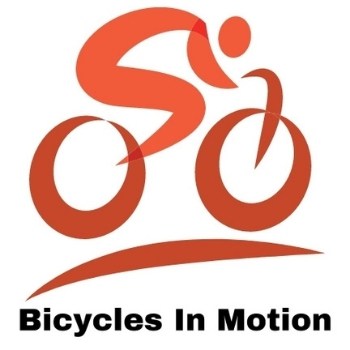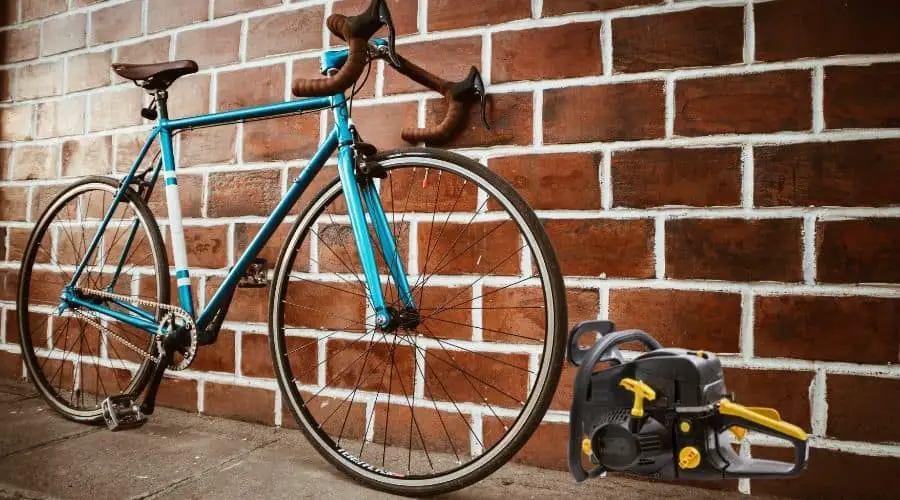Many DIY motorized bicycle builds use lawn tools like trimmer engines, but the advantage of using a chainsaw is that it’s made to run a chain. Adding power to a bike isn’t rocket science.
Anyone with the right tools can do this project. How do you put a chainsaw motor on a bicycle?
The best way to attach a chainsaw motor on a bicycle is by adding frame pieces for support so it doesn’t damage the engine or the bike. By using the existing mounts, you can make this project fully reversible. Whether you want a permanent combination or not, it’s still better to avoid welding and other irreversible building steps.
Recommended Gear
To see all of my up-to-date recommendations for bikes and cycling gear, check out this resource that I made for you!
Table of Contents
How Do You Mount A Chainsaw Motor On A Bicycle
There are so many small engines on tools that you can virtually guarantee that most of them have been attached to a bike or some form of wheeled transportation.
However, not all motors are created equal. You will need more work to add a less efficient engine but mounting a chainsaw engine on a bicycle is a natural combination.
I will walk you through the process so you can make your own chainsaw bike.
Before you begin, you will need to take your chainsaw apart and remove the ‘chainsaw’ part from the engine.
All you need is the power source. It’s also a good idea to set the carburetor for lower RPMs. After all, speed is good, but you also want control, and it’s best if no parts burn out on your test drive.
1 – Choose The Right Parts
You can do this project with just about any bike and chainsaw but starting with the right essential parts will ultimately get you a much better result.
First, they need to be of high quality. Pick a bike with a sturdy frame that is made to go fast rather than.
Next, decide whether you want a gas or electric chainsaw. Gas-powered models are loud, often require a pull-start, and they’re bad for the environment.
The advantages are that you can quickly refuel instead of stopping and recharging and adjusting the RPMs via the carburetor is easy.
Alternately, as Chainsaws Direct explains, “Electric chainsaws are light and compact… They are quieter than gas chainsaws and don’t leave the smell of gas in their wake. What’s more, when using an electric chainsaw, you don’t have to worry about mixing oil and gas. Best of all, an electric chainsaw starts with the touch of a button.”
2 – Decide Your Placement
Some builders prefer to place the engine on the frame, right between their legs. Welding is an option.
However, you can also opt to attach it by using the existing mounting on the chainsaw and metal frame pieces on the rear tire axle and crank by using a longer spindle.
You won’t need the pedals for the powered bike except as a place for your feet.
Using frame pieces attached to existing bike parts will let you set the engine behind and to one side of the bike.
Additionally, this method makes the motor a reversible DIY. You can remove it later for replacement or change your mind entirely with no damage to the bike or engine.
Depending on the model and whether you chose a gas engine, you may have to work out the exact placement.
Gas chainsaws need to vent to the rear, but you also need easy access to the power cutoff. You may need to add more complex frame pieces to rotate your motor into the correct position.
3 – Sprocket and Chain
Next, you will need to attach a sprocket and bike chain that runs from the chainsaw to the rear tire cog to make it spin around.
This is what gives your bike power. Theoretically, you could do this to the front tire instead, but a front-wheel-drive bicycle is not a good plan if you’re using a gas engine since you can poison yourself with fumes.
That said, an electric chainsaw on the front tire might be easier to start and stop since it’s a pushbutton operation, and a heavier front end is easy enough to balance.
4 – Throttle
You need to install a manual throttle on your handlebars where you can reach it. Additionally, you will need to run power from the ending to the throttle by attaching it along the bicycle’s frame.
This is similar to how brakes are set up, but instead of stopping power, it provides the opposite.
5 – Beef Up Your Brakes
If you have not upgraded or serviced your brakes in a while, you need to do that now.
Stopping an electric bicycle takes substantially more effort, and you’ll have to learn to ease off the throttle before you brake regardless.
Still, I strongly recommend a brake job before you ever turn your engine on.
Helpful Tips To Know About How To Put A Chainsaw Motor On A Bicycle
A chainsaw-powered bicycle is a fun, fast DIY project you can do at home.
However, please be safe and remember that you are riding and building at your own risk, so test carefully before taking your chainsaw bike out for a spin.
Here are more helpful tips to know about how to put a chainsaw engine motor on a bicycle.
- Please, wear safety equipment. I cannot stress this enough. You need a helmet, and it’s a good idea to wear kneepads and protection for your eyes, hands, and elbows. Crashing at speed on a motorized bike is the same as a motorcycle crash.
- Cutting and welding parts of a bicycle frame can damage its overall stability. Regrettably, this will make it more likely to bend and break. I suggest adding a framework to hold your engine instead of removing any existing part of your bike. You can easily balance the offset engine by adding storage like a one-sided saddlebag, but a compromised bike frame will never be usable again. Unless you are a professional and understand how to reinforce a bike frame, it’s best not to cut into or weld anything onto the metal.
- Placing an engine between your legs is an excellent way to get burned. A rear-engine setup is less likely to land you in the hospital. Explaining to an overworked ER doctor that you have third-degree burns from clamping your legs around a chainsaw bike engine is a situation no one needs to experience.
- Watch your gears. According to Easy E Biking, “Electric bikes generally have 1, 3, 18, 21, 24, 27, 32, or even 40 speeds. Lower numbers are the low gears, and higher numbers are the high gears. The first gear is low gear. Twenty-fourth gear is high gear.”
Final Thoughts
With the right tools and framework, anyone can build their own chainsaw bike. In fact, a chainsaw motor is meant to run a chain anyhow, making it the ideal choice.
However, you need to reign in your RPMs and install high-quality brakes to have a fully functioning DIY motorized bike.
Both the motorcycle and e-bike began at home in garages where crafty DIYers looked at motors with spinning parts and asked how to attach them to a bike wheel.
You can be part of that longstanding creative tradition by putting a chainsaw motor on a bicycle.


